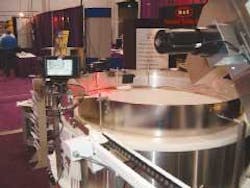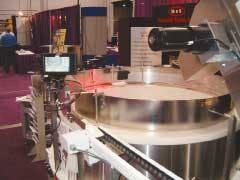Machine vision orients parts
In many industrial-automation systems, centrifugal feeder bowls transfer a particular product from a bulk state to a single lane of oriented parts. “As these parts exit the feeder bowl,” says Mark Grinager, president of M&S Automated Feeding Systems (Burnsville, MN, USA; www.msautomated.com), “they must be maintained in a specified orientation. This allows other parts of the automated machine to properly perform other tasks such as assembly, packaging, inspection, and counting functions.”
Founded in 1989, M&S now offers a range of feeder bowls in sizes from 6- to 54-in. diameter, supplied with two variable-speed dc motors to provide adjustment of both the rim and center disk speeds. “With a hand-polished stainless-steel brush finish,” says Grinager, “these feeder bowls have been specifically designed for easy removal and wash-down, making them especially useful in the food and pharmaceutical industries.”
Because the company designs and builds its centrifugal feeder bowls, they can easily be custom built for specific applications. “One of the challenges in designing these systems,” says Grinager, “is ensuring that the centrifugal force of the bowl feeder presents the correct orientation of the part to the next stage of the automated assembly system.” Although this can be done by building manual fixtures for each part, M&S recently demonstrated a bowl feeder based on a high-speed vision sensor that automatically detects the orientation of each part before it exits the system (see photo).
First shown at the recent Assembly Technology Expo (Chicago, IL, USA; August 2004), the company’s smart bowl feeder incorporates the latest PresencePLUS P4 GEO vision sensor from Banner Engineering (Minneapolis, MN, USA; www. bannerengineering.com). Based on a 128 × 100 CMOS imager, the sensor is supplied with geometric pattern-matching software, PresencePLUS GUI software for setting up inspections, digital I/O, Ethernet, and serial communications. Each part is inspected within a 2-in. field of view for a matching pattern.
“As each part travels to the rim of the feeder bowl,” says Grinager, “a Banner D10 photoelectric sensor triggers the PresencePLUS vision sensor. “Because the vision sensor offers a remote teaching feature,” says Jeffrey Schmitz, corporate business manager at Banner, “the sensor can be programmed to learn new or different parts without connecting to a PC or shutting down the line. In the configuration used in the M&S bowl feeder, the part is programmed off-line to inspect for part identification and orientation to reject incorrect parts before they are transferred to the next production stage.”
After images are captured by the sensor, they are compared to a geometric pattern of a known good part stored in the smart image sensor. A 150-mA/24-V output pass/fail trigger from the sensor interfaced to a relay supplied by PowerMation (St. Paul, MN, USA; www.powermation.com) then drives a pneumatic solenoid from SMC Corporation of America (Indianapolis, IN, USA; www.smcusa.com), which, in turn, controls a pneumatic blow-off valve. “Should the vision sensor detect that a part is improperly oriented,” says Grinager, “the relay is actuated, and the improperly oriented part is blown back into the feeder bowl where it can be later be re-presented to the vision sensor.”
“In choosing the PresencePLUS P4 GEO,” says Grinager, “we considered a number of factors such as Banner’s local product support, the performance and ease of use of the vision sensor software, and the $995 price.” This year alone, M&S expects to ship between 30 and 100 centrifugal bowl feeders equipped with vision technology. Despite some developers’ skepticism about CMOS sensors, the low cost and functionality show that it is now practical to apply vision systems in relatively low-cost machines such as bowl feeders and on manufacturing lines where it was previously impractical. “Without the need for fixturing, overall costs are reduced, and inspection throughputs are increased,” says Schmitz.
